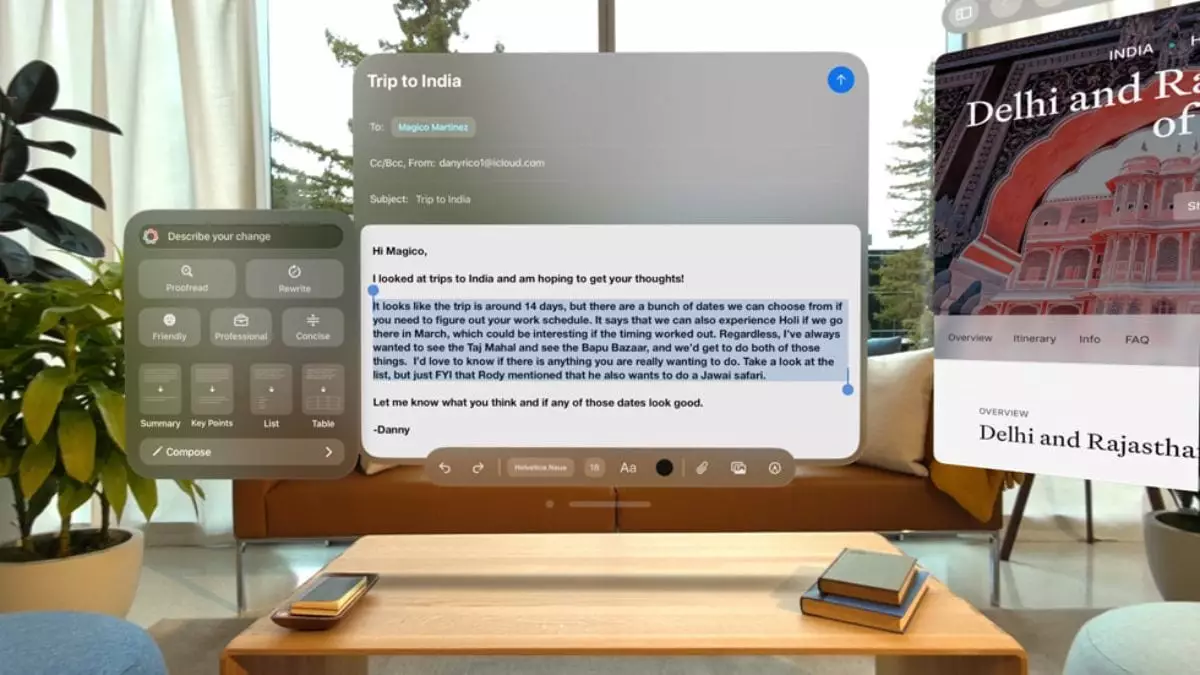Apple’s recent release of visionOS 2.4 for the Apple Vision Pro signifies an extraordinary leap forward in the realm of mixed reality technology. This update is not merely a routine enhancement; rather, it introduces a suite of AI-driven features that promise to redefine user interaction with digital content. In a world increasingly dominated by technology, Apple’s proactive approach demonstrates its commitment to pushing the boundaries of creativity and productivity, albeit with a cautious note regarding privacy and data management.
The Promising Tools—Empowering Users
The introduction of Writing Tools in the new update takes center stage, showcasing Apple’s ambition to empower users beyond conventional usage scenarios. This AI-powered tool functions as a personal editor, offering capabilities ranging from grammar checks to enhanced content creation. The ability to summarize text, generate lists, and even highlight critical points serves not just to save time but also to enhance the quality of work produced. This signals a broader trend where technology is not just a passive tool but a proactive collaborator in the creative process.
Additionally, the Image Playground and Genmoji features creatively leverage generative AI, allowing users to blend artistic inspiration with personal memories seamlessly. By converting simple photo prompts into visually striking images or unique emojis, Apple encourages self-expression and playful creativity in a digital landscape often criticized for its rigidity. This kind of user-centric innovation fosters a sense of ownership and individuality that is sorely needed in our homogenized digital culture.
A Commitment to Privacy in the Digital Age
However, with great power comes great responsibility, and this is where Apple sets itself apart. The company emphasizes user privacy in its rollout significantly, detailing how on-device processing limits data sharing and retains user control. The integration of AI features in visionOS 2.4 is accompanied by stringent measures to ensure user data is not siphoned away into nebulous cloud storage.
Apple’s stance on privacy is commendable, especially in a time when corporations are frequently scrutinized for their data handling practices. The promise that photos and videos utilized in creating memory movies remain strictly private aligns with the growing demand for transparency in an era marked by digital insecurities. This strategy not only builds trust but also positions Apple as a leader in user-centered ethical practices.
Intuitive Interactions with AI
Moreover, the natural language search capabilities herald a new avenue in human-computer interaction. With the ability to find images using conversational queries, the linear barriers of traditional search interfaces are dismantled, creating a more intuitive and human-like interaction model. This feature, alongside Smart Reply in Mail and Messages, paves the way for a more fluid and efficient workflow, appealing especially to a tech-savvy, productivity-oriented audience.
In organizing photos into cohesive memory movies, users can now relish seamlessly crafted narratives that encapsulate their journeys, further enriching their digital storytelling toolkit. Apple’s vision of merging advanced AI with personal experiences not only elevates the utility of Vision Pro but also injects creativity into everyday tasks.
A Double-Edged Sword
Nevertheless, as we marvel at the rapid advancements in technology, we must remain vigilant. While visionOS 2.4 initiates a new chapter in our digital lives, the reliance on AI for creative processes raises questions about authenticity and the future of human creativity. If we lean too heavily on these tools, will we diminish our ability to think critically or create independently?
As we embrace these cutting-edge features, it becomes essential to strike a balance between leveraging technology and preserving the essence of our creativity as individuals. VisionOS 2.4 opens exciting doors, but it also challenges us to ponder what it means to truly create in an age where machines can assist or even usurp our roles.
In summation, Apple’s visionOS 2.4 represents a radical shift in integrating AI tools into the fabric of user experience, wrapping innovation in an ethical framework designed to protect users. The question now remains—how will we adapt and define ourselves in this augmented landscape?


Leave a Reply